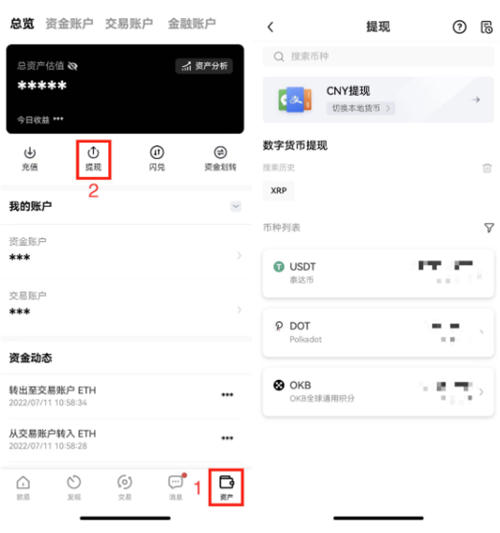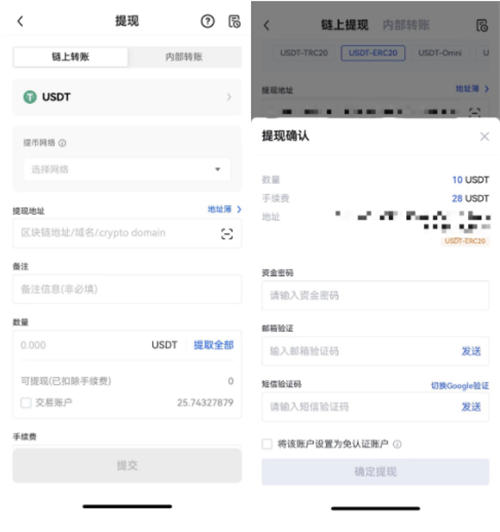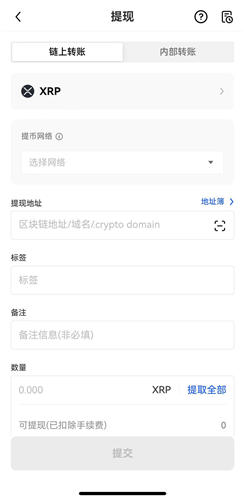 web3.0
web3.0
 A comprehensive analysis of how USDT withdraws, on-chain withdrawals and internal transfers
A comprehensive analysis of how USDT withdraws, on-chain withdrawals and internal transfers
A comprehensive analysis of how USDT withdraws, on-chain withdrawals and internal transfers
php editor Youzi will introduce in detail the two methods of USDT withdrawal: on-chain withdrawal and internal transfer. On-chain withdrawal refers to the operation of transferring USDT to other digital currency exchanges or personal wallets. What needs to be noted are the handling fees and withdrawal limits. Internal transfers are transfer operations carried out within the same exchange or platform. There is no need to pay handling fees, but they need to comply with the transfer restrictions stipulated by the platform. Understanding the processes of these two withdrawal methods will help users better manage and use USDT.
1. Withdrawal operation process on the usdt chain:
Open the Ouyi APP (click to download), select the [Assets] column - [Withdrawal] - select the currency [USDT].

Select [On-chain withdrawal], and then select the withdrawal network, taking [USDT-ERC20] as an example. Next, enter or paste the withdrawal address and fill in the withdrawal amount. Click [Submit], and then obtain and enter the relevant password or verification code as required. Finally, click [Confirm Withdrawal] to complete the operation.
Note: When choosing a withdrawal network, please ensure that the [Recharge/Coin Deposit Network] of other exchanges or wallets is consistent with Oyi, such as USDT-ERC20, to avoid losing coins.

2. USDT internal transfer operation process:
Open Ouyi APP, click [Assets], then click [Withdrawal], select the currency as [ USDT], then select [Internal Transfer], fill in the withdrawal account and amount, and then click [Submit]. Obtain and enter the relevant password or verification code as required, and finally click [Confirm Withdrawal] to complete the operation.

Reminder: When withdrawing certain currencies, you need to fill in a label, which is usually a string of numbers. For example, for XRP, in addition to filling in the withdrawal address, you also need to fill in the label below to avoid losing the coins.

3. Will I receive black coins when recharging on the usdt chain?
In the process of recharging on the USDT chain, you usually do not receive black coins directly. USDT is a digital currency. Its transaction and transfer process uses blockchain technology. Transaction records will be permanently recorded on the blockchain and cannot be tampered with.
However, it should be noted that some malicious fraud behaviors may exist, such as asking you to transfer USDT through deceptive means and recharge in the form of other digital currencies or black coins. Therefore, when performing recharge or transfer operations, be sure to carefully verify and confirm the identity and legitimacy of the payee to avoid losses due to fraud.
In addition, if you choose to use a trustworthy exchange or wallet for USDT transactions and deposits, there will generally be certain risk control and security measures in place to ensure the security and compliance of the transaction. It is recommended that you choose a formal, safe and reliable platform to operate, while keeping your personal account and transaction information safe to avoid being attacked by criminals or malicious fraud.
4. Types of usdt chains and transaction storage methods
On the USDT chain, there are currently three main types of USDT: USDT-OMNI, USDT-ERC20 and USDT-TRC20.
USDT-OMNI: USDT-OMNI is the earliest USDT version with Bitcoin (BTC) as the underlying protocol. It is issued and transmitted through Bitcoin’s Omni Layer protocol and therefore relies on the Bitcoin network for transaction confirmation.
USDT-ERC20: USDT-ERC20 is a USDT version based on the issuance and transmission of the ERC20 token standard of Ethereum (ETH). It runs on the Ethereum blockchain and uses Ethereum’s smart contract technology for transfers and transactions.
USDT-TRC20: USDT-TRC20 is the USDT version of the TRC20 token standard issued and transmitted based on the Tron blockchain. It uses Tron’s smart contract technology for transfers and transactions, with faster confirmation times and low transaction fees.
5. How to create a usdt address?
1. Download and install a wallet application that supports USDT. Some common wallet applications include TronWallet, MetaMask, Tether official wallet, etc.
2. Choose to create a new wallet or register an account in the wallet application. Follow the application guidelines and fill in the necessary information, such as username, password, mnemonic phrase, etc.
3. After completing the creation steps, the wallet application will generate a new USDT address for you. This address is the unique identifier used to receive USDT.
4. Please ensure that you keep sensitive information such as your private key, mnemonic phrase or password properly. This information is very important for you to recover your wallet, access and manage your USDT funds.
5. On the exchange or other USDT storage platform, provide your newly created USDT address to the other party in order to receive USDT transfers.
The above is the detailed content of A comprehensive analysis of how USDT withdraws, on-chain withdrawals and internal transfers. For more information, please follow other related articles on the PHP Chinese website!

Hot AI Tools

Undresser.AI Undress
AI-powered app for creating realistic nude photos

AI Clothes Remover
Online AI tool for removing clothes from photos.

Undress AI Tool
Undress images for free

Clothoff.io
AI clothes remover

AI Hentai Generator
Generate AI Hentai for free.

Hot Article

Hot Tools

Notepad++7.3.1
Easy-to-use and free code editor

SublimeText3 Chinese version
Chinese version, very easy to use

Zend Studio 13.0.1
Powerful PHP integrated development environment

Dreamweaver CS6
Visual web development tools

SublimeText3 Mac version
God-level code editing software (SublimeText3)

Hot Topics
 1377
1377
 52
52
 Qubetics ($TICS): The Revolutionizing AI Crypto
Mar 23, 2025 am 10:08 AM
Qubetics ($TICS): The Revolutionizing AI Crypto
Mar 23, 2025 am 10:08 AM
Cryptocurrency has always been a realm where the cutting edge of technology meets bold ambition, and it's only getting more exciting in the future. As artificial intelligence continues to grow in influence, there are a handful of digital assets that
 Pi Network (PI) Price Falls Despite Successful PiFest 2025 Event
Apr 03, 2025 am 10:08 AM
Pi Network (PI) Price Falls Despite Successful PiFest 2025 Event
Apr 03, 2025 am 10:08 AM
Pi Network recently held PiFest 2025, an event aimed at increasing the token's adoption. Over 125,000 sellers and 58,000 merchants participated
![Bitcoin [BTC] was on a downtrend after losing the $92,000-support level in the final week of February](https://img.php.cn/upload/article/001/246/273/174209101774967.jpg?x-oss-process=image/resize,m_fill,h_207,w_330) Bitcoin [BTC] was on a downtrend after losing the $92,000-support level in the final week of February
Mar 16, 2025 am 10:10 AM
Bitcoin [BTC] was on a downtrend after losing the $92,000-support level in the final week of February
Mar 16, 2025 am 10:10 AM
Technical indicators such as the OBV showed that selling pressure has been dominant, meaning more losses may be likely ahead.
 Top 10 digital currency app platforms rankings Virtual currency exchange latest rankings in 2025
Mar 13, 2025 pm 06:45 PM
Top 10 digital currency app platforms rankings Virtual currency exchange latest rankings in 2025
Mar 13, 2025 pm 06:45 PM
Top 10 digital currency app platforms: 1. OKX, 2. Binance, 3. Gate.io, 4. Kraken, 5. Coinbase, 6. Huobi, 7. KuCoin, 8. Crypto.com, 9. Bitfinex, 10. Gemini; these platforms are ranked according to factors such as transaction volume, security and user experience. When choosing, the platform's security, liquidity, transaction fees, currency selection, user interface and customer support should be considered.
 Where to download the genuine Ouyi? Official website download. Global
Mar 31, 2025 pm 02:09 PM
Where to download the genuine Ouyi? Official website download. Global
Mar 31, 2025 pm 02:09 PM
Ouyi usually refers to Ouyi OKX. The global way to download Ouyi OKX APP is as follows: 1. Android device: Download the APK file through the official website and install it. 2. iOS device: access the official website through the browser and directly download the APP.
 BlockDAG Launches Beta Testnet With $200M Raised, Ethereum Approaches $2,000 & Tether Expands Into Media
Apr 03, 2025 am 10:34 AM
BlockDAG Launches Beta Testnet With $200M Raised, Ethereum Approaches $2,000 & Tether Expands Into Media
Apr 03, 2025 am 10:34 AM
Ethereum (ETH) price edges toward resistance, Tether news reveals a €10M media deal, and BlockDAG reaches new milestones with Beta Testnet and growing adoption.
 Cyber criminals were able to steal cryptocurrency worth 1.5 billion US dollars
Mar 16, 2025 am 11:12 AM
Cyber criminals were able to steal cryptocurrency worth 1.5 billion US dollars
Mar 16, 2025 am 11:12 AM
Since then, the provider has been investigating how this could have happened and how it will (hopefully) not happen again in the future.
 gate.io registration tutorial
Mar 31, 2025 pm 11:09 PM
gate.io registration tutorial
Mar 31, 2025 pm 11:09 PM
This article provides a detailed Gate.io registration tutorial, covering every step from accessing the official website to completing registration, including filling in registration information, verifying, reading user agreements, etc. The article also emphasizes security measures after successful registration, such as setting up secondary verification and completing real-name authentication, and gives tips from beginners to help users safely start their digital asset trading journey.


